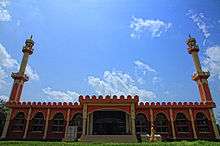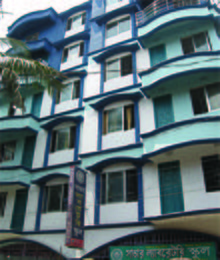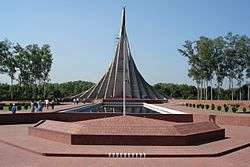Savar Upazila
| Savar or Shabhar সাভার সম্ভার Shômbhar | |
|---|---|
| Upazila | |
|
National Memorial in Savar, Bangladesh | |
 Savar or Shabhar Location in Bangladesh | |
| Coordinates: 23°51′30″N 90°16′00″E / 23.8583°N 90.2667°ECoordinates: 23°51′30″N 90°16′00″E / 23.8583°N 90.2667°E | |
| Country |
|
| Division | Dhaka Division |
| District | Dhaka District |
| Area | |
| • Total | 280.13 km2 (107.50 sq mi) |
| Population (2011) | |
| • Total |
|
| • Density | 4,951/km2 (12,820/sq mi) |
| Time zone | BST (UTC+6) |
| Post code(s) | 134.. |
| National calling code | +880 |
| Calling code | 027 [For Savar only] |
Savar (Bengali: সাভার Savar or Shabhar) is an Upazila of Dhaka District in the Division of Dhaka, Bangladesh.[1] It is located at a distance of about 24 kilometres (15 mi) to the northwest of Dhaka city. Savar is mostly famous for Jatiyo Smriti Soudho, the National Monument for the Martyrs of the Liberation War of Bangladesh.
History
The origin of the name Savar is thought to be an evolved version of the ancient 7th-8th century township of সর্বেশ্বর Shôrbeshshôr ("Lord of everything") or সম্ভার Shômbhar ("Collection") situated on the banks of the river known today as the Bangshee. It was the capital of the Sanbagh Kingdom then. Local legends claim that a king by the name of Harish Chandra ruled over Shôrbeshshôr. There is an old shloka that goes বংশাবতীর পূর্বতীরে সর্বেশ্বর নগরী, বৈশে রাজা হরিশচন্দ্র জিনি সূরপুরী Bôngshabotir purbotire shôrbeshshôr nôgori, boishe raja Horishchôndro jini shurpuri ("In Sharbeshvar city on the east bank of the Bansabati, lives King Harish Chandra conquering Heaven").
During the 1971 war, Savar Cantonment (then Ansar Camp) and the then-newly founded Jahangirnagar University were some of the first targets of military swoop outside the capital following Operation Searchlight of 25 March. In December of that year, Savar was the last obstacle before the freedom fighters (led by Kader Siddiqui and others) entered the capital and the Pakistan army conceded defeat. Days before the end of the war, teenager Golam Dastagirr Titu was killed in a direct encounter between the Pakistani army and the freedom fighters. The compatriots buried him near the main gate of the Central Cattle Breading & Dairy Farm, Savar. The Bangladeshi army constructed a memorial monument in his honour.
On 24 November 2012, a garment factory fire killed at least 112 people. The factory made clothes for US and European companies and was faulted for negligent safety standards.[2] Walmart and Sears, two of the companies who contracted work from this factory, refused to compensate victims.[3]
On April 24, 2013, a building in Savar collapsed, killing 1,129 people and injuring around 2,500.[4][5] The building housed a garment factory which exported clothing to US and European companies. Eighty percent of the workers were women aged 18–20, paid $0.12-$0.26 per hour.[6]
Geography
Savar is located at 23°51′30″N 90°16′00″E / 23.8583°N 90.2667°E. It has 66,956 units of household and a total area of 280.13 square kilometres (108.16 sq mi). It is bounded by Kaliakair and Gazipur Sadar upazilas on the north, Keraniganj upazila on the south, Mirpur, Mohammadpur, Pallabi and Uttara thanas of Dhaka City on the east, and Dhamrai and Singair upazilas on the west. The land of the upazila is composed of alluvium soil of the Pleistocene period. The height of the land gradually increases from the east to the west. The southern part of the upazila is composed of the alluvium soil of the Bangshi and Dhalashwari rivers. Main rivers are Bangshi, Turag, Buriganga and Karnatali. The Bangshi River has become polluted due to industrial. The total cultivable land measures 16,745.71 hectares (41,379.6 acres), in addition to fallow land of 10,551.18 hectares (26,072.5 acres).
Demographics
As of the 2011 Bangladesh census, Savar Upazila had a population of 1,387,426. Males constituted 54.20% of the population, and females 45.80%. This Upazila's eighteen-up population was 207,401. Savar had an average literacy rate of 58.16% (7+ years), and the national average of 54.4% literate. Male literacy was 64% and female was 51%. The religious breakdown was Muslim 88.59%, Hindu 10.41%, Christian 0.93%, Buddhist 0.03% and others 0.04%, and ethnic minority group nationals numbered 319 including Buno, Garo, Chakma (Sangma), and Burman. The main occupations are Agriculture 24.34%, agricultural labourer 12.84%, wage labourer 4.44%, cattle breeding, forestry and fishing 1.90%, industry 1.37%, commerce 17.35%, service 20.68%, construction 1.66%, transport 3.96% and others 11.46%.
Economy
Agriculture and manufacturing are the two major economic sectors in Savar. The main crops grown here are Paddy, Jute, peanut, onion, garlic, chilli and other vegetables. The extinct or nearly extinct crops in the region are Aus paddy, Asha Kumari paddy, sesame, linseed, kali mator, randhuni saj, mitha saj, kaun and mas kalai. The main fruits cultivated here are Jackfruit, mango, olive, papaya, guava, kamranga, berry and banana. There are 181 combined fisheries, dairies and poultries Dairy, 5 hatcheries, 209 poultries, and 1319 fisheries. Manufacturing facilities include Ceramic industry, beverage industry, press and publication, garments industry, foot ware, jute mills, textile mills, printing and dying factory, transformer industry, automobile industry, biscuit and bread factory, pharmaceutical industry, soap factory, brick field, cold storage, welding, plant nursery, etc. Bangladesh Export Processing Zone is located in this upazila. The Cottage industry includes 8 Weaving, 100 goldsmith and 29 others workshops. The main exports are Jackfruit, papaya, flower, sapling, dairy products, meat, transformer, fabrics, dye, medicine, ready made garments, electronics and electric goods, shoe, brick, sweetmeat etc.
| Agriculture % | Industry % | Service % |
|---|---|---|
| 23.6 | 59.6 | 16.8 |
There are 62 km of pucca (first-class), 56 km of semi pucca, 562 km of mud road; and 50 km of highway. Transports used here include the traditional (and extinct or nearly extinct) Palanquin, bullock cart and horse carriage as well as modern day vehicles.
The minimum wage is approximately $9.50 per week, or $38 per month.[7][8]
Administration
Savar has 13 Unions/Wards, 350 Mauzas/Mahallas, and 321 villages. The municipal area (Savar Town) consists of 9 wards and 55 mahallas. The area of the town is 24.1 km². It had a population of 124,885; male 53.03%, female 46.97%; population density per km² of 5182. Savar Thana was established in 1912 and was turned into an Upazila in 1983. Presently Savar Upazila divided into to 2 thanas, one is Savar Main and other is Ashulia.

Politics
Several Hindu families played a critical role in the development of the township during the British Raj in the 19th and first half of the 20th century. After partition of India in 1947, the Hindu influence in the area waned following the departure of many prominent Hindu families. The 1960s saw the establishment of some important institutions, including a dairy farm and a University in the area. Concurrently, communist politics was on the rise in the area. However, this was replaced with Bengali nationalist zeal, when the Awami League won the 1970 election in this constituency. In 1975, Savar came to the spotlight when the Maoist leader Shiraj Shikdar was secretly tortured and executed at Savar Cantonment. Savar was politically important to the military dictators of the mid-1970s and 1980s, as the cantonment armory here was the closest one outside the capital.
From the 1990s to mid-2000s, the Bangladesh Nationalist Party candidate has been routinely elected to parliament from this constituency. However, Awami League and other parties; Communist Party of Bangladesh, Socialist Party of Bangladesh, Worker's Party(Menon), National Awami Party, Sammobady Dal (including several Islamist ones) continue to have grassroots presence. The general election at the end of 2008 saw an Awami League candidate elected to parliament from this constituency. Jahangirnagar University and a few colleges in the area serve as a hotbed of active student politics and strife. Foreign dignitaries customarily visit Savar as a part of their trip to Bangladesh to pay respect to the martyrs of 1971 at the Jatiyo Smriti Soudho.





Education
There are 3 universities, 5 colleges, 6school and colleges, 38 high schools, 3 junior high schools, 16 madrasas, 88 government primary schools, 13 non-government primary schools, 12 community schools, 8 satellite schools, and 1 sports institution. Some of the noteworthy institutions are Adhar Chandra High School (established in 1913), Gana Bishwabiddalay, Bangladesh Krira Shikha Institution,
- Jahangirnagar University, a Public University, along with its School and College
- Asian University of Bangladesh, a Privet University
- Savar Model College, a Secondary Higher School
- Savar Cantonment College, a Secondary Higher School
- B.P.A.T.C School and College (Bangladesh Public Administration Training Centre)
- Savar Laboratory School and College
- Savar Laboratory Junior School
 Savar Laboratory Junior School
Savar Laboratory Junior School - Katlapur pre-cadet school
- Zirabo Cantonment School and College
Important institutions
Savar is the home of Jahangirnagar University, a Public University of Bangladesh and only University for full student residence facilities which is famous for its scenic beauty and as a prime destination for Siberian migratory birds during winter.[9]
The nation's one and only specialised rehabilitation hospital, the CRP-Bangladesh centre for the rehabilitation of the paralysed,[10] is located in Savar, about 1 kilometre (0.62 mi) from Savar Bazar.
There are many other important institutions in Savar. The 9th Division Army Savar Cantonment is located here. There is a military rirm and government dairy firm beside Jahangirnagar University. BPATC training center is the only training centre for the public service commissioned officers in Bangladesh. Radio Bangladesh (Bangladesh Betar) employers Residence and The Transmission Zone with huge Transmission Setup. (HPT-1; high power transmission, HPT-2, etc.).
The two Largest entertainment theme parks of Bangladesh namely "Fantasy Kingdom" and "Nondon Park" are also located here. Fantasy Kingdom is situated in Jamgora Bazar and Nondon Park is situated in Jirani. Bangladesh Krira Shiksha Pratisthan (BKSP), the only national sports institute of Bangladesh is also situated in Jirani Bazar. Dhaka Export Processing Zone, DEPZ is also situated in this upazila.
There are 318 mosques, 8 churches and 68 other religious institutions. The Atomic Energy Research Establishment, Satellite Ground Receiving Station (Talibabad), National Institute of Biotechnology, Bangladesh Livestock Research Institute, Savar Youth Training Centre.
The locally published newspapers and periodicals are Jagrata Kantha, Savar Barta, Saf Katha, Savar Kantha, and Ganabhasa. The officially registered cultural and social organisations here include 81 Co-operative societies, 1 children's organisation, 3 film societies, 5 cinema halls, 5 theatre groups, 1 theatre stage, 3 music centre, 5 orphanages, 1 opera party (an indigenous travelling theater troupe), 3 women's club, 1 chapter of Bangladesh Mohila Parishad, 2 Amnesty organisations, 1 golf club, 2 entertainment parks. There are numerous other unofficial organizations as well. Operationally important NGOs include Ganasastha Kendra, World Vision, Swanirvor Bangladesh, VERC, Palli Mangal Karmasuchi, CDD, Adesh, Mother Vision Society of Bangladesh etc. The health centres in Savar include 1 Upazila health complex, a combined military hospital (Savar Cantonment), the Korea Bangladesh Friendship Hospital, 7 family planning centres, 2 satellite clinics, and 21 private clinics.
The Gono University or Gono Biswobidyaloy is a private university in Savar. It was established on 14 July 1998 and is popular for its extraordinary non-smoking rule for students, teachers and staff. It was one of 11 universities that went operational without University Grants Commission (UGC) approval which was made a necessity under the Private University Act (1992). It also introduced new academic courses without UGC approval along with a number of other private universities.
See also
References
| Wikimedia Commons has media related to Savar Upazila. |
- ↑ Amal Saha (2012). "Savar Upazila". In Sirajul Islam and Ahmed A. Jamal. Banglapedia: National Encyclopedia of Bangladesh (Second ed.). Asiatic Society of Bangladesh.
- ↑ ABC News. "Fire Kills 112 Workers Making Clothes for US Brands". ABC News.
- ↑ "Bloomberg Business". Bloomberg.com.
- ↑ "Bangladesh textile factories shut amid unrest". BBC News. 16 May 2013. Retrieved 14 May 2013.
- ↑ "Bangladesh factories reopen after Dhaka disaster". BBC News. 16 May 2013. Retrieved 2 May 2013.
- ↑ "Alerts". www.globallabourrights.org.
- ↑ "Latest breaking news from Hilton Head & Beaufort, SC - The Island Packet". islandpacket.com.
- ↑ "Owner of collapsed building captured in Bangladesh". Yahoo News. 27 April 2013.
- ↑ "Migratory birds back to JU campus". The Financial Express. 20 (157). 19 November 2012. Retrieved 12 July 2013.
- ↑ "CRP Bangladesh: Centre for the Rehabilitation of the Paralysed, Official web site". Retrieved 12 July 2013.
- General
- NK Bhattasali, 'The Math Inscription of Mahendra, Son of Harish Chandra of Sabhar', Dacca Review, 1920
- GM Laskar, 'Notes on Raja Harish Chandra of Sabhar', Dacca Review, 1920
- MM Hoque, SMK Ahsan and SSM Rahman, 'Pre-Muslim Settlement and Chronology of Savar Region', Pratnatattva, 1996
- AKM Shahnawaz and MM Hoque, 'Savar: History and Archaeology', in Souvenir, 9th Bangladesh Science Conference, held in Jahangimagar University, 1996.

